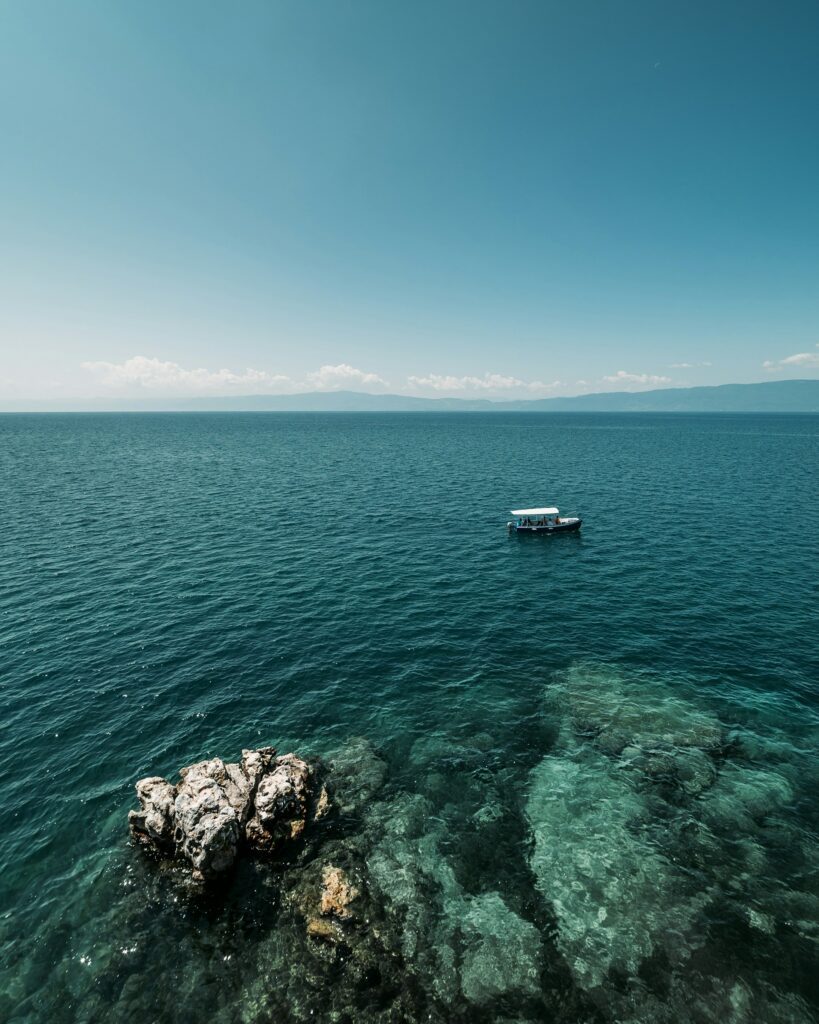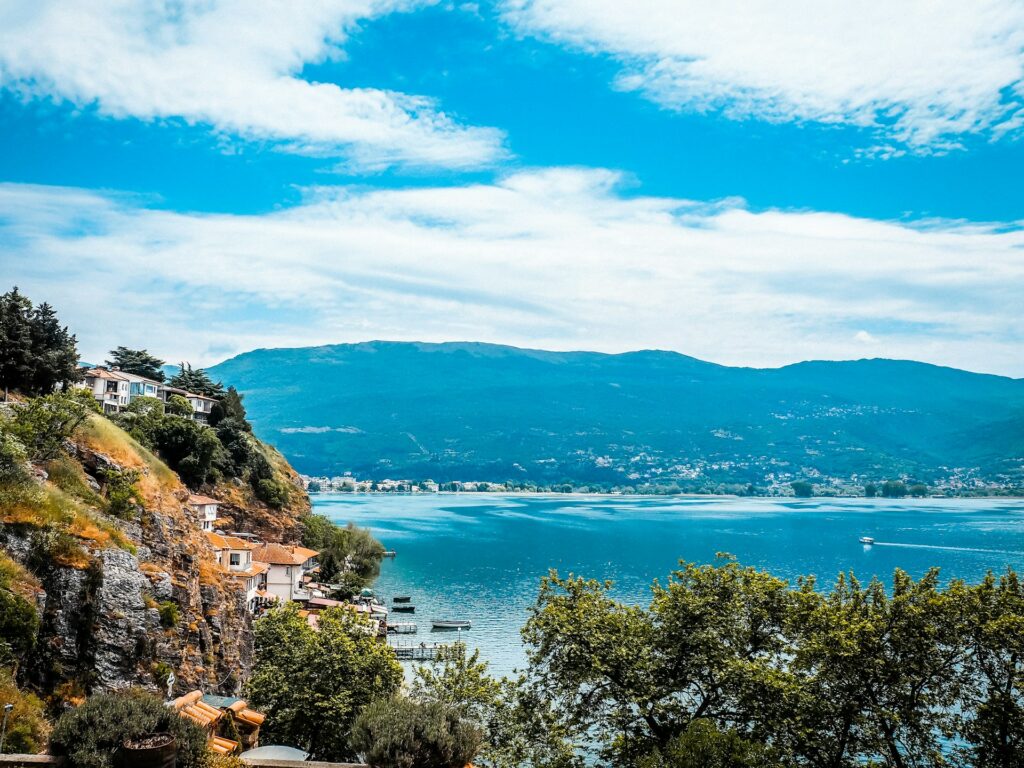When it comes to European lakes, Lake Bled in Slovenia has long been the star of the show. Its picturesque island with a church, surrounded by emerald-green waters and framed by the Julian Alps, has been splashed across Instagram feeds and travel brochures for years. But as more and more travellers flock to Lake Bled, some are starting to ask: is there a less crowded, equally stunning alternative? Enter Lake Ohrid in North Macedonia, a hidden gem that’s quickly catching the eye of Interrail travellers. With its crystal-clear waters, ancient history, and affordable prices, it’s worth asking – is Lake Ohrid the new Lake Bled?
First, What Makes Lake Bled So Special?
Before diving into Lake Ohrid, it’s worth revisiting what makes Lake Bled so iconic. Located in the Julian Alps of Slovenia, Lake Bled is known for its picturesque church on Bled Island, a tiny islet in the middle of the lake. Tourists can rent traditional wooden boats – called pletna – to row across to the island, climb 99 steps, and ring the wishing bell in the church for good luck. Towering over the lake is Bled Castle, perched dramatically on a cliff. It offers panoramic views of the surrounding mountains, adding to the fairytale vibe that has made Lake Bled a must-visit destination for nature lovers, photographers, and couples alike.
However, in recent years, Lake Bled has become incredibly popular, especially in the summer months. Crowds can sometimes make it difficult to fully enjoy the serene beauty of the lake, and the increased prices reflect its rise in fame. This has led some travellers to search for a quieter, more authentic alternative.
Enter Lake Ohrid: A Hidden Balkan Gem
Located on the border between North Macedonia and Albania, Lake Ohrid is one of the oldest and deepest lakes in Europe, with a history that stretches back over 3 million years. Its deep, clear waters are surrounded by ancient monasteries, quaint villages, and rugged mountains, offering a different, but equally captivating atmosphere compared to Lake Bled.
While Lake Ohrid hasn’t yet reached the mainstream fame of Lake Bled, it’s rapidly gaining a reputation among savvy travellers – especially those on an Interrail journey through the Balkans. So, what makes Lake Ohrid so special, and could it truly rival Lake Bled as Europe’s top lakeside destination?
Stunning Natural Beauty
One of the first things that strikes visitors about Lake Ohrid is its breathtaking natural beauty. The lake itself is an expansive stretch of deep blue water, surrounded by forested hills and towering mountains. The clarity of the water is one of its defining features—you can often see several meters down, which makes it perfect for swimming, kayaking, and even diving.

Much like Lake Bled, Ohrid offers stunning views at every turn, but with a more rugged, untouched feel. The western shore is lined with small, rocky beaches where you can relax and take in the view without having to jostle for space with other tourists. The eastern shore, closer to the town of Ohrid, offers more developed areas with restaurants, cafes, and boat tours, but even here, the atmosphere remains peaceful and laid-back.
For hikers and nature lovers, the nearby Galichica National Park provides plenty of opportunities for exploration. With its scenic trails, rare plant species, and panoramic views of both Lake Ohrid and neighbouring Lake Prespa, it’s a paradise for outdoor enthusiasts.
Historical and Cultural Riches
Where Lake Ohrid truly shines is in its rich historical and cultural heritage. The town of Ohrid, situated on the northeastern shore of the lake, is a UNESCO World Heritage site, thanks to its wealth of historical landmarks and ancient architecture. This isn’t just a lake destination – it’s a journey through time.
Ohrid is often referred to as the “Jerusalem of the Balkans” due to its abundance of churches. Legend has it that there were once 365 churches around the lake – one for every day of the year. While not all of them remain, visitors can still explore an impressive array of medieval churches and monasteries, including the stunning Church of St. John at Kaneo (pictured above). Perched on a cliff overlooking the lake, this 13th-century church is one of the most iconic images of Ohrid and provides a peaceful spot to watch the sunset.
Another must-visit site is the Monastery of Saint Naum, located near the Albanian border. This beautiful monastery, founded in the 10th century, is surrounded by lush gardens and sits near the springs that feed Lake Ohrid. It’s a serene and spiritual place, offering a unique glimpse into the region’s religious history.
In addition to its churches and monasteries, Ohrid is also home to ancient ruins, including the Ancient Theatre of Ohrid, which dates back to the Hellenistic period. During the summer months, the theatre hosts performances and concerts as part of the Ohrid Summer Festival, giving visitors a chance to experience culture in a truly historic setting.
Relaxed Atmosphere and Fewer Crowds
One of the biggest draws of Lake Ohrid compared to Lake Bled is its relaxed atmosphere. While Lake Bled is undeniably beautiful, its popularity can sometimes detract from the peaceful experience. In contrast, Lake Ohrid still feels like a hidden gem, with far fewer tourists, especially outside of peak season. You can explore the lake and its surroundings at your own pace without the pressure of large crowds.
Whether you’re kayaking in the crystal-clear waters, wandering through the narrow streets of Ohrid’s Old Town, or relaxing with a coffee by the lake, there’s a sense of calm that permeates the area. It feels more untouched, more authentic, and more relaxed – a perfect respite for Interrail travellers seeking something off the beaten path.

Affordable Prices
Let’s face it – Lake Bled, while beautiful, is no longer a budget destination. Accommodation, food, and activities have become increasingly expensive as the lake’s popularity has grown. For interrailers on a budget, this can be a bit of a challenge.
Lake Ohrid, on the other hand, is still wonderfully affordable. Whether you’re looking for a cosy guesthouse, a meal in a lakeside restaurant, or a boat trip across the water, you’ll find that your money goes a lot further here than at more touristy spots like Bled. This makes it an excellent choice for travellers who want to enjoy a beautiful, historic location without breaking the bank.
Outdoor Activities and Water Sports
Like Lake Bled, Lake Ohrid offers a wide range of outdoor activities, making it perfect for active travellers. The lake’s clear waters are ideal for swimming, and you’ll find several beaches – both rocky and sandy – along its shores. You can rent kayaks or paddleboards to explore the coastline or join one of the many boat tours that take you around the lake and to hidden coves.
For those who prefer to stay on land, Ohrid offers plenty of hiking trails, especially in the surrounding national parks. The hikes in Galichica National Park offer breathtaking views of both Lake Ohrid and Lake Prespa, with routes suitable for all levels. The more adventurous can take on the climb to Magaro Peak, where you’ll be rewarded with panoramic vistas of the entire region.
In the summer months, the Ohrid Summer Festival brings music, theatre, and dance performances to the town’s open-air venues, including the Ancient Theatre, blending culture and outdoor adventure in a uniquely Balkan way.
The Verdict: Is Lake Ohrid the New Lake Bled?
So, is Lake Ohrid the new Lake Bled? In some ways, yes – and in others, no. Lake Ohrid shares many of the same qualities that have made Lake Bled so beloved: stunning natural beauty, a rich cultural heritage, and a range of outdoor activities. However, it offers these things with fewer crowds, lower prices, and a more relaxed, off-the-beaten-path atmosphere.
For Interrail travellers looking for a destination that combines history, nature, and affordability, Lake Ohrid is an excellent alternative to Lake Bled. It may not have the fairytale castle or the iconic island church, but it more than makes up for it with its ancient monasteries, crystal-clear waters, and stunning mountain views.
In the end, whether you prefer the polished charm of Lake Bled or the rugged authenticity of Lake Ohrid will depend on your travel style. But if you’re looking for a destination that’s still under the radar, with all the beauty and culture of Europe’s most famous lakes, Lake Ohrid might just be the next big thing – if not better.